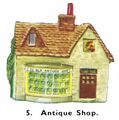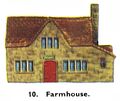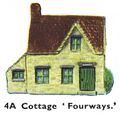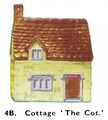Category:Cotswold Village Series: Difference between revisions
m (BTMM Eric moved page Cotswold Village Series (Tri-ang Spot-On) to Category:Cotswold Village Series) |
(+categories) |
||
| Line 1: | Line 1: | ||
{{Toymaker|Date1=1960}} | |||
{{Box|Landmarks,_Cotswold_Village_No2_(SpotOnCat_1stEd).jpg|Haystack and other smaller pieces|380}} | |||
{{Box|Post_Office,_Cotswold_Village_No12_(SpotOnCat_1stEd).jpg|P. Leete Post Office|380}} | |||
{{Box|Smithy,_Cotswold_Village_No14_(SpotOnCat_1stEd).jpg|Smithy, or Blacksmith's Cottage|380}} | |||
The 1:42-scale '''Cotswold Village Series''' sold by [[Tri-ang]] under the [[Spot-On]] name from early 1960 (or perhaps late 1959) seems to to have been the first result of [[Lines Brothers]]' takeover of the rubber moulding company '''Young and Fogg Rubber Co. Ltd.''' of Wimbledon in 1958. | The 1:42-scale '''Cotswold Village Series''' sold by [[Tri-ang]] under the [[Spot-On]] name from early 1960 (or perhaps late 1959) seems to to have been the first result of [[Lines Brothers]]' takeover of the rubber moulding company '''Young and Fogg Rubber Co. Ltd.''' of Wimbledon in 1958. | ||
| Line 33: | Line 37: | ||
{{YoungAndFogg}} | {{YoungAndFogg}} | ||
{{SpotOn}} | |||
{{Triang}} | |||
Revision as of 14:21, 6 October 2016
| Toy Brands and Manufacturers |
|---|
Cotswold Village Series |
| 1960 - |
Haystack and other smaller pieces [image info]
P. Leete Post Office [image info]
Smithy, or Blacksmith's Cottage [image info]
The 1:42-scale Cotswold Village Series sold by Tri-ang under the Spot-On name from early 1960 (or perhaps late 1959) seems to to have been the first result of Lines Brothers' takeover of the rubber moulding company Young and Fogg Rubber Co. Ltd. of Wimbledon in 1958.
The Cotswold Village items were quickly followed by a physically smaller series of Tri-ang Railways 00-gauge buildings.
Material
The rubber material and hollow moulding process produced an unusual finish, better suited for rounded stonework than brickwork, and for "rustic" buildings than those with razor-sharp edges and lines, which would show the warping and distortions of the hollow moulded rubber, so a set of models based on quaint (and irregular, and slightly saggy) traditional Cotswold buildings with a honey-coloured finish was a pretty smart idea.
It's not unusual for these hollow rubber models to start to look rather squashed after a period in storage (perhaps being leant on by other items), and it's common to find these pieces packed with newspaper or bits of wood or cardboard, either to correct an existing warpage issue caused by storage, or to prevent new problems arising. This isn't normally considered to be a sign of a serious problem – packing usually makes the moulding return to its original shape quite easily, and once a piece has been kept "packed" for a while, there's not an obvious reason to remove the packing material.
~1960 listing:
- 1 School (boxed) 11 1/2" × 8"
- 2 Memorial Stone (polythene bag) 4" × 2 1/2" ... Well Set (polythene bag) 3" × 3" ... Stocks (polythene bag) 1/2" × 1 1/2" ... Haystack (polythene bag) 5" × 4"
- 3 "Cornerstones" Cottage (boxed), 5" × 5 1/2"
- 4A "Fourways" Cottage (boxed) 7" × 6 1/2"
- 4B. "The Cot" Cottage, (boxed), 6" × 7"
- 5 Antique Shop (boxed), 7" × 7"
- 6 General Store (boxed), 7" × 7 1/2"
- 7 Town Hall (boxed), 9 1/2" × 8"
- 8 Barn (boxed) 10 1/2" × 6 1/2"
- 9 Public House (boxed), 10" × 9"
- 10 Farm House (boxed) 10" × 7 1/2"
- 11 Manor House (boxed) 11" × 10"
- 12 Post Office (boxed), 6 1/2" × 7 1/2"
- 13 Church (boxed), 11" × 11"
- 14 Smithy (Boxed)
External links
Media in category ‘Cotswold Village Series’
The following 15 files are in this category, out of 15 total.
- Antique Shop, Cotswold Village No5 (SpotOnCat 1stEd).jpg 796 × 806; 121 KB
- Barn, Cotswold Village No8 (SpotOnCat 1stEd).jpg 797 × 458; 73 KB
- Church, Cotswold Village No13 (SpotOnCat 1stEd).jpg 948 × 997; 160 KB
- Cornerstones Cottage, Cotswold Village No3 (SpotOnCat 1stEd).jpg 618 × 814; 94 KB
- Farmhouse, Cotswold Village No10 (SpotOnCat 1stEd).jpg 838 × 706; 119 KB
- Fourways Cottage, Cotswold Village No4A (SpotOnCat 1stEd).jpg 700 × 661; 90 KB
- General Store, Cotswold Village No6 (SpotOnCat 1stEd).jpg 746 × 805; 120 KB
- Landmarks, Cotswold Village No2 (SpotOnCat 1stEd).jpg 1,168 × 1,007; 140 KB
- Manor House, Cotswold Village No11 (SpotOnCat 1stEd).jpg 866 × 813; 147 KB
- Post Office, Cotswold Village No12 (SpotOnCat 1stEd).jpg 699 × 836; 110 KB
- Public House, Cotswold Village No9 (SpotOnCat 1stEd).jpg 850 × 744; 117 KB
- School, Cotswold Village No1 (SpotOnCat 1stEd).jpg 837 × 665; 105 KB
- Smithy, Cotswold Village No14 (SpotOnCat 1stEd).jpg 865 × 643; 85 KB
- The Cot Cottage, Cotswold Village No4B (SpotOnCat 1stEd).jpg 723 × 802; 101 KB
- Town Hall, Cotswold Village No7 (SpotOnCat 1stEd).jpg 886 × 817; 110 KB




















